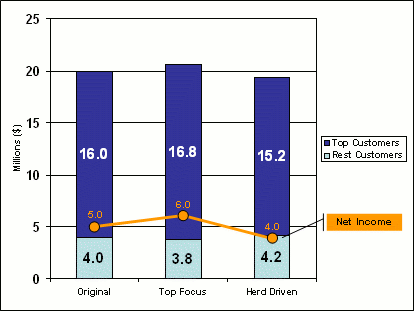Ignore the 80/20 Rule at Your PerilStrategy & Business Improvement

The 80/20 rule is relevant to many facets of the enterprise.
I originally wrote this article in 2003, but I think the points it makes are still valid and worth the quick read.
Several years ago, while working on my own, I had an engagement requiring that I analyze multiple years’ profit and loss statements of a private company. The review reinforced that 80% of the expenses were associated with about 20% of the company’s vendors and, most importantly, that focusing energies on gaining reductions in one or more of the largest expense items would realize large bottom-line savings even if the other expenses continued to grow. Prioritizing negotiations and capital projects that could help bring savings to the big expense items became a clear focus.
The engagement highlighted the relevance of the “80/20 Rule” to many facets of the enterprise:
- 80% of the revenue comes from 20% of the customers
- 80% of the expenses come from 20% of the company’s vendors
- 80% of the problems come from 20% of the customers
- 80% of the time should be spent on the 20% most important things
The 80/20 Rule is often also referred to as the “Pareto Principle” after an observation by Italian economist Vilfredo Pareto in 1906 that 20% of the people controlled 80% of the wealth. The principle became popularized by quality management pioneer Dr. Joseph Juran who extended the observation about the “vital few and trivial many.” Dr. Juran observed that 20% of something are always responsible for 80% of the results. He championed a focus on the 20% of defects causing 80% of the problems. The 80/20 Rule is a reminder to put 80% of our energy on the 20% of things that matter most. When applied to the Income Statement this means focusing on the key revenue sources and the key expense items rather than losing focus chasing the “trivial many.” When applied to customer or business segments, it reminds us to identify and focus on retaining the 20% of customers or business responsible for 80% of the profit.
passengers for airlines
For some businesses the 80/20 Rule might be more of a 90/10 or 70/30 Rule, but that doesn’t dilute the value of the lesson.
Take as an example three of the major publicly traded airlines: American (AAL), Delta (DAL), and Southwest (LUV). Each airline reports that passenger transportation accounts for more than 90% of the revenue. Imagine if American, Delta, or Southwest Airlines management decided to devote 80% of the mindshare to the non-passenger business. If the result was even a 10% decline in the passenger business, it would more than cancel out the entirety of the contribution of the non-core businesses. Indeed, these companies should be sure their forays into non-passenger businesses are very profitable and not simply a management distraction.
Partner Brands
Concern about management distraction was put forth by the management of McDonald’s as justification for jettison of its’ Partner Brands (largely Boston Market, Chipotle, and Donato Pizza). The Partner Brands accounted for less than 7% of the total revenue at McDonald’s, but the CEO suggested that the Partner Brands received more than 7% of the corporate mindshare, leading to a neglect of the portion of the business responsible for 93% of the revenue. Of course, the reason McDonald’s bought the Partner Brands was to increase revenue growth. But, to match a 1% increase in the core business, a 14% increase in the Partner Brands would be needed — certainly food for thought.
cost cutting
Returning to the passenger airline example, but this time looking at the other side of the ledger, we find that salaries, wages, and benefits constitute some 40% of the expenses, while fuel represents about 12 – 15% of the total expenses. That means a 3% reduction in fuel costs is needed for the equivalent savings as a 1% reduction in labor costs. This knowledge should dictate management’s focus when it comes to cost cutting. That is, the level of effort required for a 1% adjustment in fuel costs should be considered against the level of effort required for a 1% adjustment in labor costs, which is of greater value. Faithfully employing this logic, at some point the focus for expense reduction might shift from one cost center to another as the value versus effort tradeoffs change. In a large organization where more than one front of expense attack can be maintained, resource allocations should still be considered against this backdrop.
scenario analysis
The chart illustrates a company with $20 million in revenue and $15 million in expenses. For illustration, the company follows the 80/20 Rule: 20% of customers are responsible for 80% of the revenue and 20% of expense categories are responsible for 80% of the costs. Suppose a focus on the top customers and top expense categories leads to a 5% boost in revenue and a 5% reduction in expenses from each. Futhermore, suppose this focus results in a 5% loss in revenue from the bottom 80% of customers and a 5% increase in expenses in the other 80% of categories. The business still would experience a 21% increase in net income as compared to doing nothing. Moreover, the net income results are 53% higher than if the attention and effects were reversed (that is, focused on the herd).

maintaining perspective
It is important to not lose sight that the 80/20 Rule also cautions against solitary focus — the 20% still needs to be given attention. Simply, it should not receive undue attention. That is, the 80/20 Rule reminds us to maintain perspective in a world of competing demands. Bottom line: management attention should be proportionally allocated based on revenues and savings potential.

